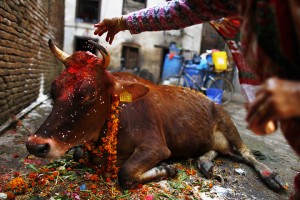 Families in Nepal are celebrating the annual Hindu festival Gai Jatra, or the “Procession of Cows,” in an effort to help deceased loved ones reach Heaven.
Families in Nepal are celebrating the annual Hindu festival Gai Jatra, or the “Procession of Cows,” in an effort to help deceased loved ones reach Heaven.
The festival is said to have its roots in ancient times when Hindus worshiped Yamaraj, the “god of death.” According to Hindu beliefs and legend, people would hold the tail of a cow as they crossed the Baitarni River in order to make it to Heaven. In the religion, cows are sacred, and even their dung and urine is seen as valuable.
During the Gai Jatra festival, all families that have lost a relative over the past year are to participate in a procession in the public streets, most often in the nation’s capital of Kathmandu, being led by a cow. If the family is unable to obtain a cow for the event, then a young boy must be dressed up in a cow uniform.
However, the outfit donned by the boy is not the traditional cow costume that some might expect. He wears a rather abstract, grotesque looking mask and is covered in layers of colorful clothing, often accentuated with a variety of flowers. Reportedly, if a man in the family passes, the boy dresses as a male, but if a girl is among the deceased, the boy dresses as a female.
Those that gather to watch the procession may bring gifts to give to the boy, such as milk, rice or fruit.
“It is fun to be dressed like this and receive lots of sweets and fruits,” Dilip Dangol, age 10, told Reuters.
“We believe in this, and it is our culture,” added Pritan Bariya, a 28-year-old whose sister passed away two months ago. “It will lead my sister to the doors of Heaven.”
Christian missionary Jesse Boyd of Full Proof Gospel Ministries, who has regularly conducted mission trips to the country over the past decade, recently spent several months living and ministering in Nepal.
He recalled an incident that happened during last year’s “Procession of Cows” festival as he and a fellow missionary preached outside of Swayambou Stupa in Kathmandu, also known as “the Monkey Temple,” which is one of Tibetan Buddhism’s most sacred sites.
“As I was preaching, a cow literally walked up and stood with its rear end right beside me. It started to urinate, making a big splash, so I had to grab the speaker and get out of the way,” Boyd explained. “In these moments, an old man ran up and began washing his hands and face in the urine as it was coming out of the cow. It was the strangest and most ridiculous thing I had ever seen. Even more bizarre is that no one standing around seemed to think that there was anything odd or wrong with that picture.”

He further described the year-round atmosphere the country, where cows are allowed to roam free through the city.
“You can see them walking the streets in Kathmandu, sometimes napping in the middle of a busy traffic intersection with no care for all the passing cars, motorbikes and smoking trucks,” Boyd outlined. “I have seen cows nearly cause traffic accidents on numerous occasions because people will not blow the horns at this ‘sacred animal’ and some would rather die than run into the bovine napping in the street.”
He advised that there are a number of festivals that take place throughout the year that include not only cows, but other common animals.
“In late autumn, after the [Gai Jatra] festival, there is a day during Tihar in which cow dung is actually worshiped. In fact, Tihar, a five-day ‘festival of lights,’ begins with the worship of crows, followed by the worship of dogs, cows, cow dung and then brothers,” Boyd explained. “On the dog and cow days, it is ridiculous to see these animals walking down the street covered in bright-colored powder, garlands and gaudy decoration. The dogs, in particular, really look like they are hating life.”
“There are a lot of problems, and there is a lot of suffering in Nepal,” he continued. “The cause across the board is idolatry. Nepal is a prime example of how idolatry paralyzes a nation. Everything from bad roads to pollution and electricity blackouts is rooted in the religious superstition and the wicked caste system. Sadly, these things sometimes creep into the church. Even the Christians, because of their backgrounds, find it difficult to eat beef, so practicing Romans 14 is of utmost importance.”

Boyd stated that only one percent of the Nepalese population professes to be Christian, with Hinduism and Buddhism being the prominent religion; therefore, festivals such as the “Procession of Cows” are widely celebrated.
In light of this, he said that missionary work is not only necessary, but quite fulfilling.
“I don’t think you could find a more corrupt government in all of the world, but in this, the doors have swung wide open for the Church,” Boyd relayed. “Even the staunchest of Hindus, the very ones who participate in the ‘Procession of Cows,’ are wise enough to know there is an almighty Creator that they can never understand apart from some sort of special revelation.”
“All the religious superstition and the sacrificial system of Hinduism makes the book of Hebrews and the Old Testament typology of Christ as the sacrificial lamb of God good open-air preaching in Kathmandu and the villages,” he outlined.
Boyd distributed over 123,000 Gospel portions and tracts while living in the country, and preached in front of many Hindu and Buddhist temples.
The festival is held in different cities across the country and will be winding down in the next few days.
Become a Christian News Network Supporter...


